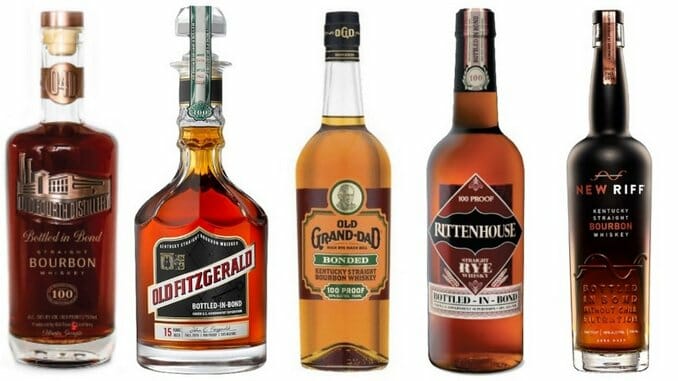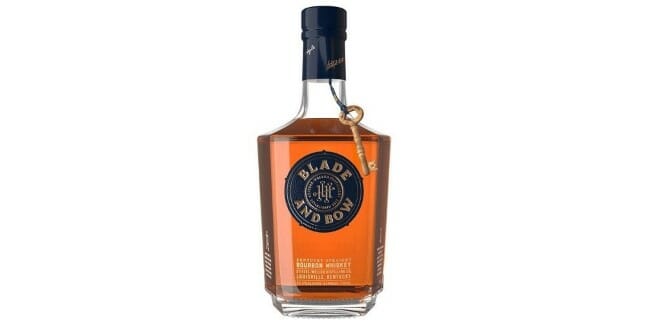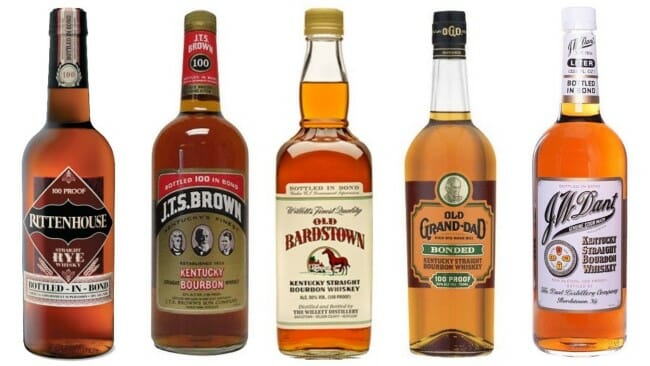
Cocktail Queries is a Paste series that examines and answers basic, common questions that drinkers may have about mixed drinks, cocktails and spirits. Check out every entry in the series to date.
You may recall, from our 5 Questions on Bourbon piece a few weeks ago, that the term “straight” on a bourbon bottle essentially functions as a federal guarantee of a certain level of quality. This is because bourbon is pretty well-defined by the U.S. government, and words on bourbon bottles tend to have concrete meanings. In the case of “straight,” a whiskey bearing that label must have been aged for at least two years, with no additional colorings, flavorings or non-whiskey spirits added. It’s intended to let the consumer know: “Hey, I represent a bare-bones baseline of quality,” protecting the drinker from potentially buying a quasi-“bourbon” aged for only a few months.
The term “bottled-in-bond,” (BiB) on the other hand, might best be thought of as representing another jump forward in that same line of thinking and consumer protection. The term has more hurdles for a distillery to jump over, promising a spirit of reliable quality and strength. For more than a century, drinkers have been able to see the phrase “bottled-in-bond” and know what they were getting, although the term is now in the midst of a modern revolution.
To start with, though, let’s define bottled-in-bond bourbon. Note: The bottled-in-bond term can actually be applied to any U.S. spirit, but it’s only commonly used with whiskey, most often bourbon and rye.
Bottled-in-Bond Definition
To be labeled as bottled-in-bond, your average bourbon must meet the following requirements:
— The spirit must be produced in the U.S., during a single distillation season (defined as January-June, or July-December), at a single distillery. This alone makes bonded whiskey distinct from many straight bourbons, which can be intermingled whiskeys from multiple distillation seasons and distilleries.
— The whiskey must be aged in a federally bonded warehouse under U.S. government supervision for at least four years. It can be aged longer, but four years is the baseline, and the most common timeframe. If you see no actual age statement on a bonded whiskey, four years is often a safe bet.
— The whiskey will be bottled at exactly 100 proof (50% ABV), which traditionally has made bottled-in-bond bourbons a good source of “bang for your buck.”
— The label is federally required to identify the distillery where the product was distilled, and where it was bottled if different, for the sake of transparency.
So why was such a tightly regulated definition necessary in the first place? Put simply, it was because bourbon of the late 1800s was anything but palatable much of the time. We’ve written in the past about the astronomical levels of American liquor consumption during the 1800s, but left out of that discussion is the fact that the quality level of these spirits would have been all over the place, with consumer fraud sadly running rampant. A lack of U.S. truth-in-advertising laws meant that practically anything could be dumped in a bottle and labeled as bourbon, and there was clear incentive for shady distillers to cut corners rather than take the time to properly age their spirits. To that end, whiskey was sometimes being adulterated with everything from fruit syrups to tobacco or potentially toxic chemical additives in order to make it seem older. Government intervention to ensure the safety of drinkers (as well as the health of the spirits industry) simply became a necessity.
The result was the Bottled-in-Bond Act of 1897, often credited as being the first consumer protection act in U.S. history. In addition to establishing the definition of bottled-in-bond whiskey seen above, it also assigned overview of those “bonded” warehouses to agents of the Treasury Department, who physically possessed the keys to lock and unlock the distillery warehouse doors on a daily basis. The legacy of this system can still be seen throughout the whiskey industry today, in brands like Blade & Bow, which comes adorned with Treasury Department keys.
 Though its design is a reference to federally bonded warehouses, Blade and Bow is ironically not actually a bottled-in-bond product.
Though its design is a reference to federally bonded warehouses, Blade and Bow is ironically not actually a bottled-in-bond product.
If you’re wondering what was in it for the distilleries, beyond the fact that the label would increase consumer confidence in the quality of their bourbon, the government struck a deal that was beneficial to both groups: Distilleries were allowed to delay payment of their excise taxes on bourbon stored in bonded warehouses until the whiskey had finished aging. The government, meanwhile, maintained access to those warehouses in order to ensure correct accounting of how much would be owed. Each side was essentially getting what they wanted, and the distilleries quickly fell in line, led by Colonel Edmund Haynes Taylor, Jr.—a powerful political figure with stakes in several distilleries, including the OFC Distillery that would eventually become today’s Buffalo Trace. Today, BT’s small batch line of E.H. Taylor whiskeys pays homage to Taylor’s influence, particularly in helping to establish the Bottled-in-Bond Act of 1897.
Bottled-in-Bond Whiskeys Today
Classically, “bottled-in-bond” whiskey was seen as a mark of quality, something a distillery could be proud to sell and consumers would be eager to buy. Before Prohibition, they often would have been a distillery’s most prized offering.
By the time the 1990s and early 2000s rolled around, however, the bottled-in-bond terminology was seen as being on its last legs. Because the brown spirits industry had been in decline since the 1970s, and was dominated by larger, older producers with vast stores of well-aged stock, a merely “four year” bourbon didn’t seem particularly novel to anyone. Increasingly, bottled-in-bond bourbons were relegated to the bottom shelf, and many of the brands were characterized by drinkers as “old man” whiskeys. They often represented fantastic values in budget whiskey, via brands such as Old Grand-Dad, Old Fitzgerald or J.T.S. Brown, but there was no denying that “bottled-in-bond” carried a certain archaic stigma. If things had continued on that way, the label might very well have eventually disappeared entirely.
 A lineup of old-school BiB bourbon and rye.
A lineup of old-school BiB bourbon and rye.
In the last decade, however, the bottled-in-bond term has been positively revitalized by a new wave of interest in the terminology. One of the main factors in this rebirth? Craft distilleries.
As the 2010s began, and the brown liquor boom was in full swing, a new wave of craft distilleries began to lay down roots in the U.S. Many of these distillers had dreams of producing whiskey, but the downside of whiskey is that it takes a long time to have well-aged stock that conforms to tradition. Some distilleries dealt with this issue by turning to a variety of tricks to accelerate aging, such as smaller barrel sizes or honeycombed oak containers, but many possessed the patience to wait for properly aged bourbons. By the second half of the decade, some of those whiskeys were finally coming of age, which heralded the second coming of bottled-in-bond bourbon from small craft distilleries.
In effect, this new wave of BiB bourbons served to reclaim the idea that BiB represented a “premium” product, because to many of the small, independent distilleries, that’s exactly what their new BiB bourbon was—the culmination of all their efforts up to that point. Distilleries that had been open for half a decade finally had “big boy” bourbons they could compare to the classic whiskeys of Kentucky, and some of them—such as the bottled-in-bond bourbon from Atlanta’s own Old Fourth Distillery—are damn good whiskeys in their own right. As is normal in craft distilling, these whiskeys carried higher price points, which elevated the level a consumer would expect to pay for something labeled bottled-in-bond.
 Members of a new BiB generation.
Members of a new BiB generation.
This in turn led to an unexpected turnabout from the major whiskey distilleries of Kentucky, who clearly noticed that the term “bottled-in-bond” was coming back into vogue. Subsequently, distilleries like Heaven Hill redesigned several of their older, dated-looking bottled-in-bond whiskeys, re-releasing them at higher price points and in fancier packaging. Look no further than the namesake Heaven Hill Bottled in Bond, which is now a 7-year product with a price tag soaring past $50 in many stores, and Old Fitzgerald Bottled in Bond, a 15-year-old bourbon that costs $150 or more. Both were once bottom-shelf brands, but now they have a new lease on life, thanks to the renewed interest in bottled-in-bond.
Today, the lineup of available bottled-in-bond bourbons has never been bigger or more varied. Some, like Old Grand-Dad, have retained their bottom shelf budget bourbon status. Others have become ultra-luxe limited releases, or mid-shelf craft staples. The term has never before been applied to so many styles of whiskey at once, making this arguably the second golden age of the bottled-in-bond term.
Just a little something to keep in mind, the next time you’re browsing the whiskey aisle.
Jim Vorel is a Paste staff writer and resident liquor geek. You can follow him on Twitter for more drink writing.